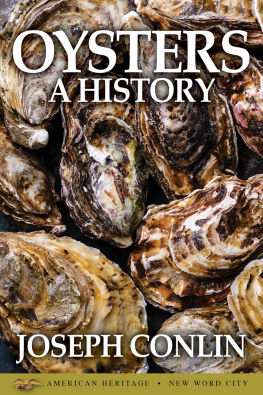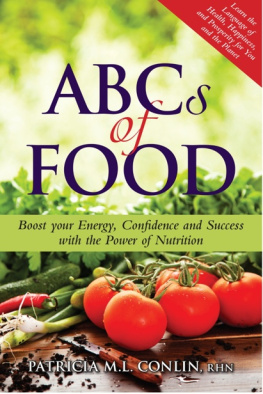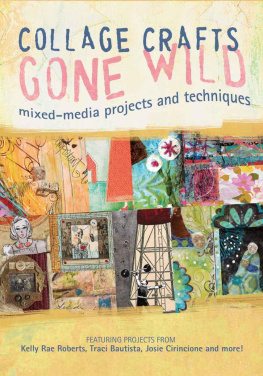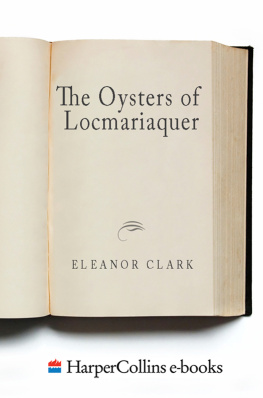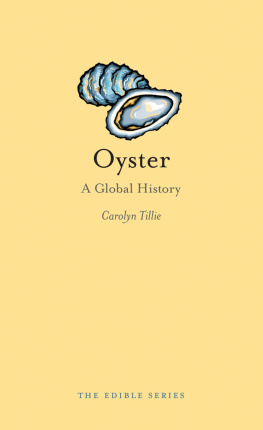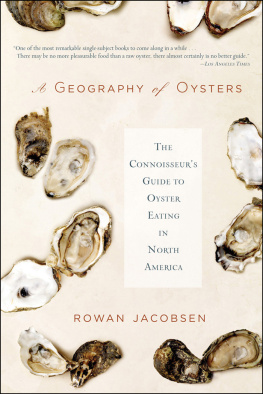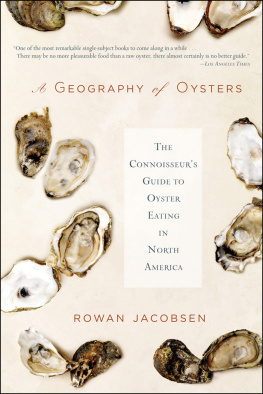Conlin - Oysters: a history
Here you can read online Conlin - Oysters: a history full text of the book (entire story) in english for free. Download pdf and epub, get meaning, cover and reviews about this ebook. City: Rockvill;MD, year: 2017, publisher: New Word City, Inc.;American Heritage : New Word City, genre: Romance novel. Description of the work, (preface) as well as reviews are available. Best literature library LitArk.com created for fans of good reading and offers a wide selection of genres:
Romance novel
Science fiction
Adventure
Detective
Science
History
Home and family
Prose
Art
Politics
Computer
Non-fiction
Religion
Business
Children
Humor
Choose a favorite category and find really read worthwhile books. Enjoy immersion in the world of imagination, feel the emotions of the characters or learn something new for yourself, make an fascinating discovery.
- Book:Oysters: a history
- Author:
- Publisher:New Word City, Inc.;American Heritage : New Word City
- Genre:
- Year:2017
- City:Rockvill;MD
- Rating:3 / 5
- Favourites:Add to favourites
- Your mark:
- 60
- 1
- 2
- 3
- 4
- 5
Oysters: a history: summary, description and annotation
We offer to read an annotation, description, summary or preface (depends on what the author of the book "Oysters: a history" wrote himself). If you haven't found the necessary information about the book — write in the comments, we will try to find it.
It saved the early American colonists from starvation, it has caused men to murder each other, and it was once our most democratic food - in short, an extraordinary bivalve. Here, in this essay by historian Joseph Conlin, is the oysters surprising history.
Conlin: author's other books
Who wrote Oysters: a history? Find out the surname, the name of the author of the book and a list of all author's works by series.
Oysters: a history — read online for free the complete book (whole text) full work
Below is the text of the book, divided by pages. System saving the place of the last page read, allows you to conveniently read the book "Oysters: a history" online for free, without having to search again every time where you left off. Put a bookmark, and you can go to the page where you finished reading at any time.
Font size:
Interval:
Bookmark:
The oyster is an ancient species and one that has evolved little over millions of years. It is found in the tidal waters of every continent but Antarctica, on the shores of every sea but the Caspian. It flourishes best in the bays and estuaries where saltwater and freshwater mix and people build resorts. And despite the saying that it was a bold person who first ate one, the oyster has been consumed by humans since before their oldest certifiable man-made artifact.
But the oyster is no ordinary food. From time to time since the Romans, enlightened individuals have recognized extraordinary qualities in the family Ostreidae, and about the middle of the nineteenth century, Americans joined in what amounted to a mass, democratic cult, virtually worshiping the creature. The privileged few usually define their delicacies in terms of how rare and expensive they are. But in an America lit by gaslights, high societys every fine meal began with the same oysters that could be had on the street for pocket change by the rudest laborer.
The abundance of oysters is older than their glorification. The generation that founded Jamestown, for example, regarded oysters as poor fare. Their great poet, William Shakespeare, described oysters as foul and linked them with the poorhouse. Their king, James I, is the earliest candidate for the authorship of the jaundiced assessment that he was a valiant man who first adventured on eating of oysters. A medical writer of the period formalized the inhibition against eating oysters in months without an r in their names. Boats that hauled oysters were thought fit in the off season for nothing but hauling wood or manure.
Even though oysters were cheap and plentiful in Europe, the abundance of the Chesapeake beds astonished the early colonists . Sailors reported in amazement finding oyster-shell shoals large enough to capsize a boat. It appears from the earliest descriptions of these navigational hazards that only desperation could drive someone to eat the creatures. But that is what happened. In the winter of 1609, known as the Starving Times, Jamestown survived only because more than sixty of the first families of Virginia dragged themselves downriver where they subsisted on little but Crassostrea virginica , the native American oyster. Captain John Smith seemed to shudder when he described their plight, but on the other hand, Smith could relish oysters, too, when he was sufficiently hungry. On a voyage of exploration, he and his companions once came upon a place where the Savages... had made a great fire, and had been newly a rosting Oysters. They ate some and sportingly pronounced them very large and delicate in taste.
In 1680, settlers in Maryland complained they were so poorly provisioned that in order to keep from starvation, they were reduced to eating the oysters taken from along the shores. A generation later, William Byrd of Westover complained that an indolent inhabitant of the Great Dismal Swamp, like the ravens... neither plowed nor sowed but subsisted chiefly upon oysters, which his handmaid made a shift to gather from the adjacent rocks. The Pilgrims of Plymouth were more discriminating: They fed their clams and mussels to the hogs, but they kept the oysters for themselves.
By the time of the American Revolution, people had apparently acquired the taste. Oysters were still food for the poor: Slaves rolled theirs in cornmeal and fried them, and in Southern coastal areas, slave cabins sometimes seemed barricaded by great mounds of [C. virginica] shells. But by then oysters were a fixture on elegant tables in the Big House as well. Landen Carter of Sabine Hall, who otherwise hardly mentions food in his diary (except to complain about how his slaves stole it from him), lovingly records every arrival of a wagonload of oysters. He fretted when a shipment was late and dashed off intemperate inquiries to his supplier. Once in July 1776 when Carter got his hands on eight bushels, he pickled six and polished off two on the spot. According to his diary, he was far more preoccupied with defying the r taboo than with the rebellious proceedings in Philadelphia. When a troubled neighbor reminded him of the r rule, Carter shewed he not only could eat them but did it in every shape, raw, stewed, caked in fritters and pickled.
Long within reach of the poor, C. virginica was now also coveted by the rich. And its accessibility was not limited to the coasts for the oyster could be educated. That is, it could be taught to clamp its shell tightly shut by a procedure involving several cycles of immersing it suddenly in weak brine and just as abruptly draining it off. This simulated the tides with which oysters had coped for millenniums, except that these human- induced ebbings and floodings were erratic, indeed - several short cycles and then a long, dry, low tide for purposes of transit with which, obligingly, the oysters came to terms. In this way, Blue Points could be hauled not only to the eastern metropolitan markets; they and a shimmering variety of Cotuits , Wellfleets , Cape Cods, Narragansetts, Gardiners Bays, Peconic Bays, Oyster Bays, Fire Islands, Girdletrees , Kent Islands, Lynnhavens, Bobbins Islands, and Chincoteagues could be shipped far into the interior. Even before the railroad, great lumbering express wagons hauled live oysters hundreds of miles inland. An ambitious former congressman named Abraham Lincoln seems to have been admired locally for his oyster feasts, and several times, the Lincolns threw parties at which huge quantities of the mollusks were eaten raw and subjected to every method of cookery then practiced in Springfield, Illinois.
One oyster recipe that would not have made its way to Illinois was Hangtown Fry, a California Gold-Rush specialty. The memory of the eastern oyster apparently haunted the forty-niners. Indeed, their monotonous hardtack and soda-bread diet made them willing to pay as high as $1 apiece for the bivalves. (An oyster sold for a cent on an eastern wharf at the time.) The demand was such that, in 1851, a schooner plied its way up the Pacific coast, through Oregon and into Washington, shucking and sampling as it went, in search of supply. The best were found in what soon became Oysterville, Washington, a place which, in Gilded Age atlases, was labeled in larger type than Seattle or Tacoma. Although the tiny, native Olympia oyster is noted for its flavor, it never made the big commercial splash of its distant eastern cousin. But the Olympia was the oyster that figured in the invention of the gold miners special.
The story goes that a miner from Shirt-tail Bend, California, whooped into the big city (Hangtown) loaded with nuggets and dust. At the Cary House Hotel, he demanded the most expensive meal they served. The most expensive ingredients , he was told, were oysters and eggs. Fair enough. One version has the cook inventing the dish, and another has him following the miners orders, but in any case, he poured beaten eggs over frying oysters, and Hangtown Fry was born.
On the whole, the European tourists of the era were condescending toward American oysters. In 1837, Captain Frederick Marryat, responding to the American complaint that English Colchesters and French Belons tasted of copper, replied that the Americans were correct; European oysters did taste of copper, and thats the reason we do not like American oysters, copper being better than no flavor at all.
Even the sniffy captain was awed by the abundance of oysters in the United States, however. It was a country where the recipes began, Take 200 nice oysters.... Mrs. J. Chadwicks successful Home Cookery of 1853 spoke of enhancing a Gumbo Soup with 100 oysters as if she were writing add salt to taste.
Another famous traveler was impressed by the size of the American varieties. Upon being presented with half a dozen six- to eight-inch beauties, William Makepeace Thackeray first selected the smallest one . .. and then bowed his head as though he were saying grace. Opening his mouth very wide, he struggled for a moment, after which all was over. I shall never forget the comic look of despair he cast upon the other five over-occupied shells, wrote a companion.
Next pageFont size:
Interval:
Bookmark:
Similar books «Oysters: a history»
Look at similar books to Oysters: a history. We have selected literature similar in name and meaning in the hope of providing readers with more options to find new, interesting, not yet read works.
Discussion, reviews of the book Oysters: a history and just readers' own opinions. Leave your comments, write what you think about the work, its meaning or the main characters. Specify what exactly you liked and what you didn't like, and why you think so.

